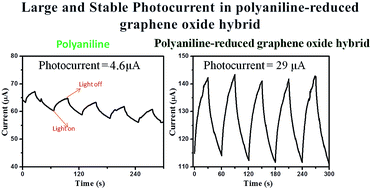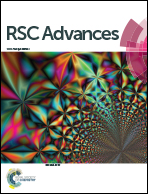Phenylenediamine functionalized reduced graphene oxide/polyaniline hybrid: synthesis, characterization, improved conductivity and photocurrent generation†
Abstract
Phenylenediamine functionalized reduced graphene oxide (GONH2) is designed and synthesized for the preparation of a polyaniline/reduced graphene oxide hybrid having better interactions than that of the unfunctionalized graphite oxide/polyaniline hybrid. Hybrids are synthesized by the in situ polymerization of aniline in the presence of GONH2. Defects generated in GONH2 during functionalization are repaired during hybrid formation. Due to the presence of free amino groups in GONH2, it will participate in the polymerization of aniline and covalent bonds will be formed between polyaniline and GONH2, resulting in the increased room temperature conductivity and photocurrent generation compared to pure polyaniline and polyaniline/graphite oxide hybrid synthesized in the same experimental conditions. Significant reduction and exfoliation of graphite oxide after functionalization with phenylenediamine, formation of direct conducting pathways by covalent connections and the photoinduced electron transfer between polyaniline and GONH2 plays a major role for the improved electrical conductivity and photocurrent generation.


 Please wait while we load your content...
Please wait while we load your content...